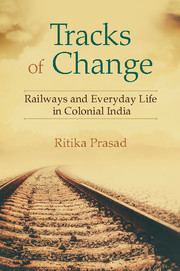Book contents
- Frontmatter
- Dedication
- Contents
- List of Tables and Figures
- Acknowledgements
- List of Abbreviations
- Introduction
- 1 The Nature of the Beast? An Elementary Logic for Third-Class Travel
- 2 Demand and Supply? Railway Space and Social Taxonomy
- 3 Crime and Punishment: In the Shadow of Railway Embankments
- 4 Railway Time: Speed, Synchronization, and ‘Time-Sense’
- 5 Contagion and Control: Managing Disease, Epidemics, and Mobility
- 6 Designing Rule: Power, Efficiency, and Anxiety
- 7 Marking Citizen from Denizen: Dissent, ‘Rogues,’ and Rupture
- Conclusion
- Bibliography
- Index
- About the Author
5 - Contagion and Control: Managing Disease, Epidemics, and Mobility
Published online by Cambridge University Press: 05 September 2015
- Frontmatter
- Dedication
- Contents
- List of Tables and Figures
- Acknowledgements
- List of Abbreviations
- Introduction
- 1 The Nature of the Beast? An Elementary Logic for Third-Class Travel
- 2 Demand and Supply? Railway Space and Social Taxonomy
- 3 Crime and Punishment: In the Shadow of Railway Embankments
- 4 Railway Time: Speed, Synchronization, and ‘Time-Sense’
- 5 Contagion and Control: Managing Disease, Epidemics, and Mobility
- 6 Designing Rule: Power, Efficiency, and Anxiety
- 7 Marking Citizen from Denizen: Dissent, ‘Rogues,’ and Rupture
- Conclusion
- Bibliography
- Index
- About the Author
Summary
In June 1916, an agent of the Bengal–Nagpur Railway (BNR) asked the Bengal government to clarify the link between railway travel and the spread of infectious diseases in India. Recent official analyses of sanitary conditions along India's pilgrimage map not only implicated railways in disseminating infectious diseases but also suggested that the situation would deteriorate further: as railway communication became ‘better and quicker,’ infectious diseases would spread ‘faster and further.’ The Bengal government however, had a differing opinion, blaming the insanitary conditions of railway travel itself for outbreaks of epidemics, especially during periods of heavy traffic. Which was it to be, enquired the agent?
The decades in which India's railway network began carrying unprecedented numbers of people further, faster, and more frequently were the same ones in which cholera and plague effected substantial ravages among India's population. While cholera epidemics preceded the advent of railways in colonial India, David Arnold estimates that at least 23 million people died of the disease in British India between 1865 and 1947. Similarly, Ira Klein describes the savage impact of plague in the two decades after its outbreak in Bombay in 1896, calling it ‘India's most feared and one of its deadliest maladies.’ He estimates a toll of at least 12 million, pointing out that ‘India was recorded as having suffered about 95 percent of the world's plague mortality from the onset of the modern pandemic down to World War II.’ Both the increasing speed and facility offered by railways were important in this context: Arnold writes of how cholera's terror was exacerbated by ‘the speed with which the disease spread,’ while Klein describes how ‘plague rode the rails and steamships’ out of Bombay. The colonial medical and sanitary establishment further scrutinized the link between railways and epidemics because trains facilitated mass travel to pilgrimage centres, places deemed as especially ripe for the spread of contagion—the immersion of Hindu pilgrims in sacred tanks or rivers was seen to provide ‘almost ideal conditions for the rapid transmission of the water-borne [cholera] vibrio.’
- Type
- Chapter
- Information
- Tracks of ChangeRailways and Everyday Life in Colonial India, pp. 165 - 199Publisher: Cambridge University PressPrint publication year: 2015



